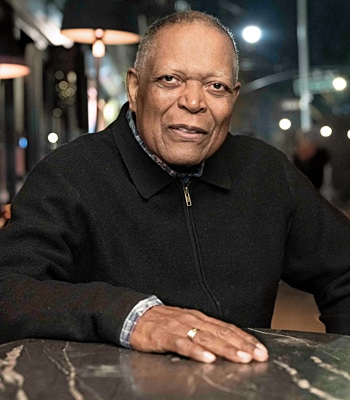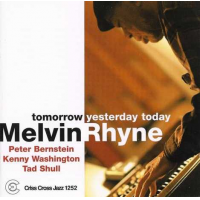Home » Jazz Articles » Liner Notes » Fridolin Blumer: Beyond Scope
Fridolin Blumer: Beyond Scope
The film follows Jeffrey "The Dude" Lebowski, played by Jeff Bridges, who is mistaken for a millionaire of the same name. The mix-up draws him into a convoluted plot involving ransom money, a kidnapped trophy wife (who fakes her own abduction), and a cast of eccentric characters, from nihilists and pornographers to avant-garde artists and bowling fanatics. The Big Lebowski revels in absurdity, much like the world of free improvisation—often dismissed as chaotic or directionless.
At one point, a group of self-proclaimed nihilists tells The Dude, "We believe in nothing, Lebowski. Nothing." Their philosophy echoes the common criticism that free improvisation lacks structure or purpose. But countering that perspective is The Dude's friend Walter Sobchak, a Vietnam veteran played by John Goodman. Walter insists on precepts, famously snapping at an opponent during a bowling match: "Smokey, this is not 'Nam. This is bowling. There are rules." His frustration could just as easily come from a jazz purist confronted with free improvisation. "Has the whole world gone crazy?" Walter exclaims. "Am I the only one around here who gives a shit about the rules?"
Though The Big Lebowski follows an unconventional path—much like a free improvisation performance—it has amassed a cult following, inspired an annual festival (Lebowski Fest), and even spawned a faux religion (Dudeism). Its appeal lies in the way The Dude adapts to each bizarre character and situation he encounters, shaping the film's rhythm organically.
The Coens drew inspiration from another film that similarly flouts traditional narrative rules: The Big Sleep (1946), directed by Howard Hawks and starring Humphrey Bogart and Lauren Bacall. Based on Raymond Chandler's novel, the plot meanders through blackmail, murder, gangsters, and a pornography ring, all while indulging in crackling dialogue and simmering sexual tension. Like The Big Lebowski, the film ignores conventional storytelling norms, yet it remains a cinematic masterpiece.
This brings us back to free improvisation. Is it a lawless, nihilistic approach to music—an expression of "believing in nothing?" Or does it have a structure, an unspoken but understood framework? While jazz was built on improvising within melodies and chord changes, free improvisation discards those constraints. Yet, as Walter Sobchak insists, "This is not 'Nam. There are rules." These rules were perhaps best articulated by British bandleader John Stevens, who helmed the Spontaneous Music Ensemble: If you can't hear another musician, you're playing too loud. If your music doesn't regularly relate to what you're hearing from others, why be in the group? In other words, free improvisation isn't an exercise in chaos; it's an ongoing conversation. The best improvisers listen as much as they play.
This philosophy is evident in the quartet Blumer-Dell-Geisser-Morgenthaler, a group born from two long-standing ensembles: Collective 4tet and Ensemble 5, both helmed by percussionist Heinz Geisser.
Collective 4tet was Geisser's American-based ensemble, featuring bassist William Parker, pianist Mark Hennen, and either trombonist Jeff Hoyer or trumpeter Arthur Brooks. Meanwhile, Ensemble 5 was his European counterpart, built around bassist Fridolin Blumer, trombonist Robert Morgenthaler, and pianist Reto Staub. Over the years, Ensemble 5 welcomed guest musicians, including saxophonist Vincent Daoud, violinist Naoki Kita, and woodwind player Elliott Levin.
For The Human Factor (2024), Ensemble 5 added vibraphonist Christopher Dell. With Staub's departure, Dell became a permanent member, forming the latest iteration of Geisser's vision.
What makes this group compelling is not only their deep well of experience in improvisational settings but their ability to embody Stevens' guiding principles. Listening to this quartet interact affirms the idea that free improvisation is not about rejecting structure entirely—it's about creating it moment by moment.
Each musician's choices are informed by the others, their playing a reflection of deep attentiveness. The music ebbs and flows, a collective dialogue rather than individual monologues competing for dominance. If one listens closely, it's possible to hear them listening—to sense their responsiveness in real time.
This is what distinguishes free improvisation from mere chaos. It isn't about believing in nothing—it's about believing in the shared act of creation. Like The Big Lebowski, it may not follow a traditional path, but that doesn't mean it lacks depth, meaning, or impact.
Ultimately, the best free improvisation performances—and the best films—are those that refuse to be bound by rigid formulas yet still adhere to a fundamental sense of logic and cohesion. They remind us that while structure is important, the real magic happens in the space between the rules.
So yes, Smokey, just like bowling, there are rules in free improvisation.
Track Listing
Beyond Scope; Spectra; Source; Matrix; Canvas; Out There; Beyond Scope - radio cut.
Personnel
Fridolin Blumer
bass, acousticChristopher Dell
vibraphoneRobert Morgenthaler
tromboneHeinz Geisser
percussionAlbum information
Title: Beyond Scope | Year Released: 2025 | Record Label: Ezz-thetics
Tags
PREVIOUS / NEXT
Support All About Jazz
 All About Jazz has been a pillar of jazz since 1995, championing it as an art form and, more importantly, supporting the musicians who make it. Our enduring commitment has made "AAJ" one of the most culturally important websites of its kind, read by hundreds of thousands of fans, musicians and industry figures every month.
All About Jazz has been a pillar of jazz since 1995, championing it as an art form and, more importantly, supporting the musicians who make it. Our enduring commitment has made "AAJ" one of the most culturally important websites of its kind, read by hundreds of thousands of fans, musicians and industry figures every month.




























